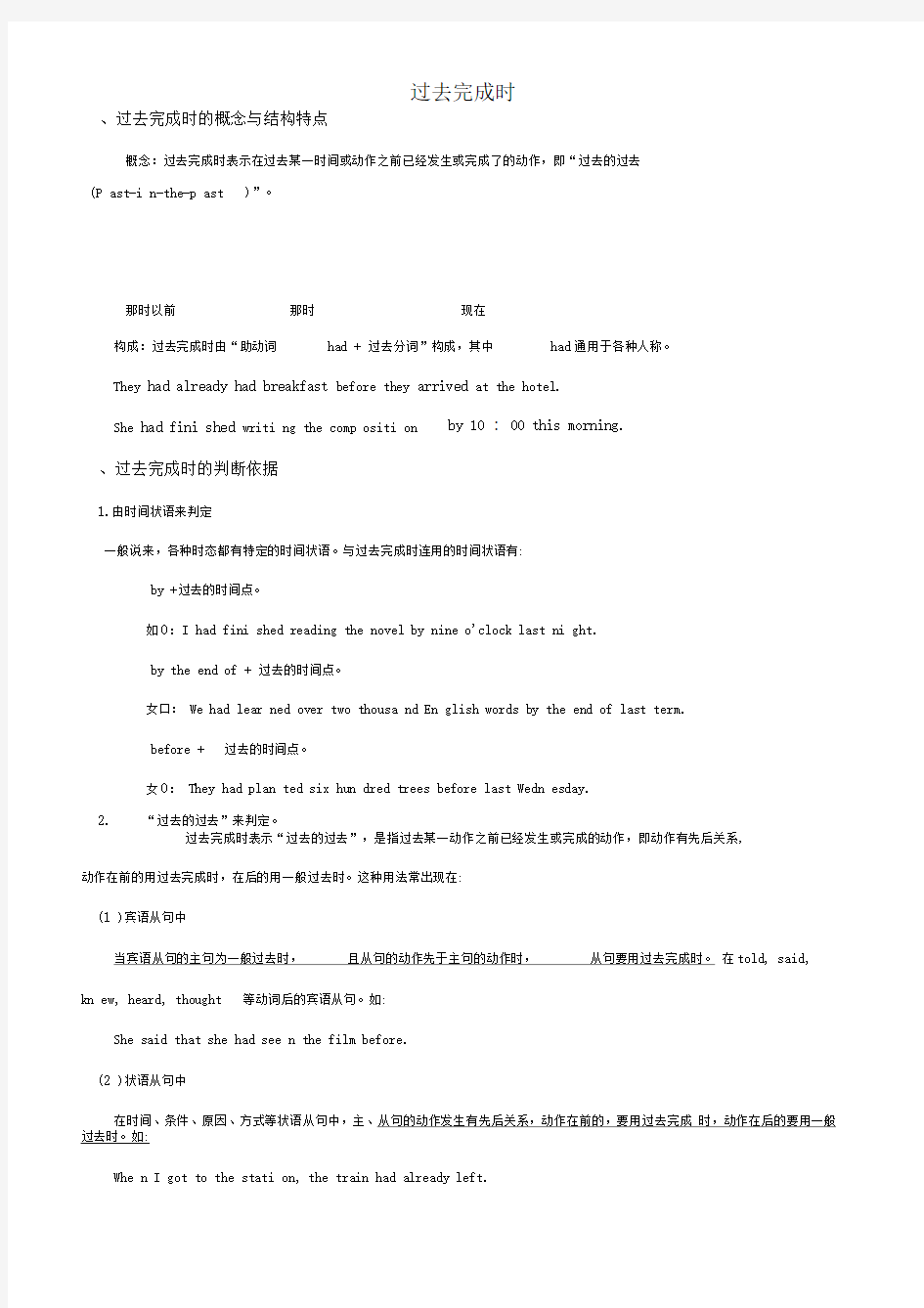精华版过去完成时讲解


、过去完成时的概念与结构特点
概念:过去完成时表示在过去某一时间或动作之前已经发生或完成了的动作,即“过去的过去
构成:过去完成时由“助动词 had + 过去分词”构成,其中 had 通用于各种人称。
They had already had breakfast before they arrived at the hotel.
She had fini shed writi ng the comp ositi on 、过去完成时的判断依据
1.由时间状语来判定
一般说来,各种时态都有特定的时间状语。与过去完成时连用的时间状语有:
by +过去的时间点。
如0: I had fini shed reading the novel by nine o'clock last ni ght.
by the end of + 过去的时间点。
女口: We had lear ned over two thousa nd En glish words by the end of last term.
before + 过去的时间点。
女0: They had plan ted six hun dred trees before last Wedn esday.
过去完成时表示“过去的过去”,是指过去某一动作之前已经发生或完成的动作,即动作有先后关系,
动作在前的用过去完成时,在后的用一般过去时。这种用法常出现在:
(1 )宾语从句中
当宾语从句的主句为一般过去时, 且从句的动作先于主句的动作时, 从句要用过去完成时。 在told, said, kn ew, heard, thought 等动词后的宾语从句。如:
She said that she had see n the film before.
(2 )状语从句中
在时间、条件、原因、方式等状语从句中,主、从句的动作发生有先后关系,动作在前的,要用过去完成 时,动作在后的要用一般过去时。如:
Whe n I got to the stati on, the train had already left.
过去完成时
(P ast-i n-the-p ast )”。
那时以前
那时 现在
by 10 : 00 this morning.
2. “过去的过去”来判定。
仍然有继续下去的可能。
如: By the end of last year, he had worked in the factory for twenty years.
有了 20 年,还有继续进行下去的可能) 5. 过去完成时 也用于 hardly...when... (刚…就…) , no sooner...than... (刚…就…) , It was the first time + that
等一些固定句型中 。
He had no sooner left the room than they began to talk about him.
We had hardly begun when we were told to stop.After he had finished his homework, he went to bed. 注意: before, after 引导的时间状语从句中,由于 before 和 after 本身已表达了动作的先后关系, 若主、从句表示的动作紧密相连,则主、从句都用一般过去时。如: Where did you study before you came here? After he closed the door, he left the classroom. 3 )表示意向的动词,如 hope, wish, expect, think, intend, mean, suppose
等,用过去完成时表示
"原本…,未能…" We had hoped that you would come, but you didn't. 3. 根据上、下文来判定。 I met Wang Tao in the street yesterday. We hadn't seen each other since he went to
Beijing.
三、过去完成时的主要用法 1. 过去完成时表示一个动作或状态在过去某一时间或动作之前已经完成或结束, 即发生在 “过去的过去” 。如: When I woke up, it had stopped raining. 我醒来时,雨已经停了。 (主句的动作发生在“过去的过去” ) 2. 过去完成时是一个相对的时态, 表示的是 “过去的过去” ,只有和过去某一时间或某一动作相比较时才使用 它。如: He told me that he had written a new book. (had written 发生在 told 之前 ) 3. 过去完成时需要与一个表示过去的时间状语连用,它不能离开过去时间而独立存在。此时多与 already yet , still , just
before , never 等时间副词及 by , before , until 等引导的短语或从句连 用。 如: Before she came to China, Grace had taught English in a middle school for about five years. Peter had collected more than 300 Chinese stamps by the time he was ten. 4. 过去完成时表示某一动作或状态在过去某时之前已经开始,
一直延续到这一过去时间, 而且动作尚未结束,
had worked 已
他刚离开房间,他们就议论起他来。
我们刚开始就被叫停。
It was the first time that he had ever spoken to me in such a
他用这样的语调跟我讲话,这是tune.
第一次。
四、过去完成时与现在完成时的区别
现在完成时表示的动作发生在过去,但侧重对现在产生的结果或造成的影响,与现在有关,其结构为“助动词
have (has) + 过去分词”;过去完成时则是一个相对的时态,它所表示的动作不仅发生在过去,更强调“过去
的过去”,只有和过去某时或某动作相比较时,才用到它。试比较:
I have learned 1000 English words so
far.
到目前为止我已经学会了1000 个英语单词。
I had learned 1000 English words till
then.
到那时为止我已经学会了1000 个英语单词。
对不起,让你久等了。
—I'm sorry to keep you
waiting.
—Oh, not at all. I have been here only a few
minutes.
没什么,我只等了几分钟。(“等”的动作从过去某一时间点持续到现在)
—John returned home yesterday. 约翰昨天回到家的。
—Where had he been?
他去哪儿了?(答语中使用过去完成时是指约翰在returned home 之前去了哪些地方,即“过去的过去” )
五、过去完成时与一般过去时的区别
虽然这两种时态都表示过去发生的动作或存在的状态,但在使用时应注意以下几点:
1. 时间状语不同:过去完成时在时间上强调“过去的过去” ;而一般过去时只强调过去某一特定的时间。试比
较:
They had arrived at the station by ten
yesterday.
They arrived at the station at ten
yesterday.
2. 在没有明确的过去时间状语作标志时,谓语动词动作发生的时间先后须依据上下文来判断:先发生的用过
去完成时,后发生的则用一般过去时。如:
She was very happy. Her whole family were pleased with her, too. She had just won the
first
in the composition
competition.
3. 当两个或两个以上接连发生的动作用and 或but 连接时,按时间顺序,只需用一般过去时来代替过去完
成时;另外,在before ,after as soon as 引导的从句中,由于这些连词本身已经表示出时间的先后,
因此也可以用过去时来代替过去完成时。如:
He en tered the room, turned on the light and read an evening
paper.
I (had) called her before I left the office.
英语中,已经有了一个过去一般时表示在过去发生的动作,
时的关键概念是:假设在过去发生了两件 (或以上)的事件,一件是 A 事件,另一件是 B 事件,如果 A B 两个
哪个事件先发生,就用过去完成时;哪个事件后发生,就用过去完成时。在上面的假设中,如果A 事件先发生, A 就用过去完成时;如果 B 事件先发生,B 就用过去完成时;而不管两件事是用什么样的时间状语或其它形式
表示的。
请看例句:
office.
在上面的五个例子中,我们只要稍微分析一下,就可以发现:每个例子讲述的内容中,都包含着两个(或以上) 过去完成时呢?请看下面的例句:
[例 1: By the time he was twelve, Edis on had bega n to make a liv ing by himself.
过去时间的“先、后”关系。
首先,句子中有个明确的过去时间点: 12岁。说他“ 12岁”,显然是过去式。那么,紧接着说“他已经开始谋
重点
为什么还有过去完成时呢?要记住: 过去完成 事件几乎是同时发生的,那就用一般过去时;但是,如果
A 、
B 两个事件不是同时发生的,怎么办呢?那就是: [例 1: She said (that) she had n ever bee n to P aris.
[例 2: Whe n the p olice arrived, the thieves had run away.
[例 3: We had hoped that you would come, but you did n't.
[例 4: Tom was disa ppoin ted that most of the guests had left whe n he arrived at the party. [例 5: The stude nts were writi ng, busily whe n Miss Brown went to get a book she had left in the
在过去发生的事件。
我们将两件事抽取出来看一下, 就非常明白:必定有一件事是先生的, 另一件是后发生的: [例 1:
said had n ever bee n to (先没有“去”,后“说”) [例 2:
arrived had run away.( 先“跑”了,后“到”) [例 3:
had hoped would come ..... d id n't ( 先“希望”,后才发生“没去” [例 4:
was disa ppoin ted had left arrived (先“离开”,后“到达” [例 5:
were writi ng we nt ... had left (先“离开”,后“到”和“写” 难点
过去完成时的难点在于:
有时候一句话中并没有出现两个事件, 因此无法比较两个事件的先后。 那为什么也用
实际上,在上面的例句中,仍然有着“先、后”之分的。不过,这次不是
A B 两件事件的先后, 而是有两个
生了”,这个“谋生”是发生在“ 12岁”时,还是“ 12岁”前,还是“ 12岁”后?答案是肯定的:他的“谋
生”发生在“12岁”之前!也就是说,“12岁”已经是一般过去时,而在“ 12岁”之前发生的事,当然是过去 完成时。所以,在那么多表示时间状语的词中,大家要特别注意 Un til 等的用法。可以说,在讲述过去的事件中,
如果出现By ……时间状语,很有可能要用过去完成时了。(当
for six mon th.
发生在then 之前(包括then )。所以此句用的是过去完成时。
再举两个例子,请大家自己分析:
[例 3] We had learned about 4000 English words by the end of last term.
[例 4] I waited until he had finished his homework.
[例 5] We had got to the station before 10:00. By 、
然,我说的是很有可能。)类似的时间表达方式还有 Un til 、Before 等。只要大家把握了过去完成时的基本含 义,不管句子怎么变化,应该没有多大的问题。例如:
[例 2 ] Un til the n, his family had n't heard from him
此句的分析同上面差不多。首先有个明确的过去时间点
"therr (那时),而"hadn't heard"
